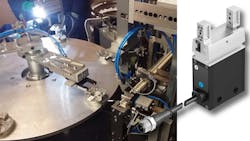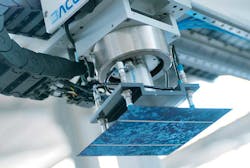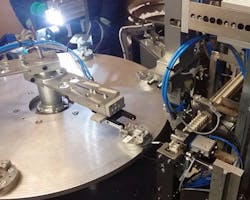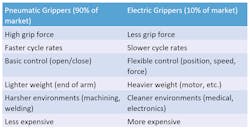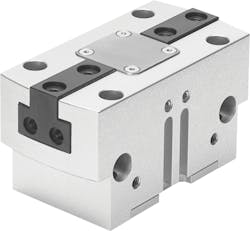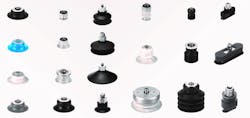Robotics Spur Growth in Grippers and Suction Cups
Grippers have become an important part of material handling in industries ranging from electronics manufacturing to automotive assembly. In North America alone, for example, the gripper market is worth roughly $100 million, and that number is expected to grow by 5% annually.
The growth in the use of grippers is tied to the rise of robotics, including the need for robots to take on special tasks and handle increasingly complex workpieces. So, now designers have more types of grippers to choose from than ever. But with all the recent developments in robotics and gripping technology, it can be difficult to know which gripper is best for a specific application.
Mechanical Grippers
When it comes to handling applications, pneumatic and electric mechanical grippers are the most common. Pneumatic grippers, which make up 90% of the market, tend to be lighter and more cost-effective than their electric counterparts. They also have higher grip forces, handle faster cycle rates and are more suitable for harsh environments.
Electric grippers, on the other hand, offer greater precision and give users better force and travel control. At the same time, they tend to be heavier due to their motors and other internal components, which also increases their upfront costs.
Whether electric or pneumatic, mechanical grippers fall into several design classes. Parallel grippers, for example, incorporate fingers that pull directly apart. Two-finger parallel grippers are the most common, making up 85% of the mechanical gripper market. Three-finger designs can handle round objects and perform centering functions.
Other mechanical rippers include radial and angular versions with fingers that open at an angle. Radial grippers open to 180 deg., letting them handle workpieces of varying sizes. Angular grippers only open to 30 deg., but they are faster than radial grippers.
Other important considerations when selecting a mechanical gripper include the gripping force, the jaw’s guiding strength and the gripper itself, all of which depend on the nature of the workpiece. In general, the longer the gripper fingers, the longer the lever arm, which exerts more torque on the jaws. In addition, flat-finger designs provide a friction-based grip for bulky or durable parts, while encapsulated designs work best on slippery parts requiring precise placement. Encapsulated fingers are shaped to match the object being moved, such as curved for round objects, which helps the grippers hold the object in position and prevent parts from dropping if pressure is lost.
For example, a company approached us wanting a gripper for a food processing application. The grippers had to pick up large trays of dried pasta, rotate the trays to dump the pasta onto a conveyor belt and then return the trays to their stack. The trays were large, roughly 4 × 2 ft. They were also made of metal and weighed 15 lb. Other important considerations included: Environmental. The grippers would operate at room temperature. The air was dry but contained some pasta dust. Design constraints. The gripper had to handle high forces, as the 15-lb trays had to be frequently rotated and shaken.
To meet these requirements, we recommended four heavy-duty HGPT mechanical grippers. Their oval-shaped piston gave them 30% more gripping force for heavy objects. They also have sealed air ports to keep pasta particles out of the gripper jaw guide.
Soft and Adaptive Grippers
Soft and adaptive grippers can handle workpieces of various shapes, sizes, and orientations, letting companies install automation in areas where it couldn’t previously fit. They don’t have sharp edges, and so can lift and move food, glass, and other delicate objects without damaging or marking the surface. They’re also ideal for small work areas. Compared to mechanical variants, however, soft, and mechanical grippers are less precise and operate slower. They are also more susceptible to dirt, oil and other contaminants.
Soft and adaptive grippers often incorporate innovative tweezer-like designs that adapt to workpieces’ contours workpieces. For example, Festo’s DHAS features a Fin Ray structure, named for the movement of a fish tail. Two flexible bands which meet at the top like a triangle are connected by ribs. Using flex hinges, these ribs are spaced at regular intervals, creating a flexible, yet sturdy connection. Available in lengths of 60, 80 and 120 mm, this series is well-suited for pick-and-place applications involving fragile or irregularly shaped parts. The grippers are made of materials that comply with FDA standards, making them a good fit for the food and beverage industry.
Vacuum Grippers
Vacuum grippers combine suction cups and vacuum generators. Compact and flexible, these grippers need little workspace and can handle a variety of objects at high speeds. But vacuum grippers can run up the maintenance and operating costs; suction cups are susceptible to quick wear, while generators consume lots of compressed air and can easily clog if dust or other contaminants are present.
When it comes to suction cups, it’s important to consider the workpiece when selecting a material. Buna, polyurethane, and Viton suction cups, for example, are ideal for oily and plain workpieces, while silicon is best for food, as well as hot or cold objects. Polyurethane is also good for rough workpieces, while Viton can handle hot objects. And anti-static buna is ideal for electronics.
Cup shape is another important factor, especially when it comes to gripping objects: Flat cups are good for round, slim or sturdy objects, while round cups work best with round, large or delicate pieces.
In general, use standard cups for flat or slightly undulating surfaces. Specify bellows cups for pliable workpieces, as well as parts with beveled, domed, and rounded surfaces. Bellows cups are also suitable for glass bottles, lightbulbs and other delicate objects. Oval cups are a good choice with slim or oblong workpieces. And extra deep cups are well suited for round and domed workpieces, providing more rigid support compared to a bellows type and handling dynamic, high-speed lateral movements.
Vacuum sources fall into two categories: electro-mechanical vacuum pumps/blowers and compressed air-driven vacuum generators/ejectors. In general, electromechanical pumps and blowers can deliver high vacuums (up to 99.99%) and suction rates (up to 1,200 cubic meters per hour). However, these machines tend to be heavy and large, requiring a reservoir with complex piping. They also run continuously, so they consume a lot of current, which generates heat.
Compressed-air-driven generators, especially single-stage units, overcome many of these limitations. Compared to electro-mechanical pumps and blowers, they are more compact, lighter and easier to install. They include simpler piping subsystems, require lower upfront costs and have no electrical connections that add complexity and create harmful heat buildup. Although these units can run up air consumption rates, many machines now have energy-saving functions to lower those rates.
In general, vacuum grippers are ideal for material handling applications, such as steel fabricators, conveyors, electronic assembly, and industrial robotics; food and packaging tasks, including canning, bottling, capping, tray making, filling, bagging, sealing, conveying, box making and labeling; and printing applications, such as sheet feeding and paper handling.
Magnetic Grippers
Magnetic grippers—e.g., Magswitches—can handle metallic objects such as metal sheets, and can carry out tasks such as de-stacking, fixture tooling and bin picking. Magnetic grippers are limited to applications involving ferrous metals. On the upside, they need minimal air consumption to actuate, so they save up to 90% in energy costs compared to suction cup grippers. Other benefits include:
- Strong gripping. Magnetic grippers use a shallow magnetic field that enables them to handle de-stacking. For example, with a stack of metal parts, magnetic grippers can pick up just one part at a time.
- True On/Off. Magnets can be switched completely off and stay clean; any metal fillings left from production processes instantly fall away.
- Fast. Magnetic grippers can actuate in 250 msec, saving valuable cycle time.
- Safe. They provide fail-safe performance and will not drop parts if there’s a loss of power or air.
Ultimately, choosing the right gripper depends on several variables, including workpiece size and shape, operating conditions, industry, energy requirements and cost. In some cases, an application may require a custom gripper. If that’s the case, your engineering team will need to work with a company that can supply them.
Michael Guelker and Daren O’Driscoll work in product management/pneumatic drives at Festo Inc., Canada.
Understand the Application
To get the right gripper, it’s important to first consider the nature of the task, operating environment and workpiece, including its size, mass and material. Here are some key considerations and questions that will help determine which gripper type will get the job done as safely and efficiently as possible:
Environmental. What temperature range will the gripper operate in? Will the gripper be exposed to dirt, dust, oil or moisture?
Industry. Does the application involve food or other hygienic workpieces? Will the gripper be exposed to cleaning processes? Does the application require antistatic materials?
Design constraints. What direction of motion is needed? What is the application’s maximum operating speed? How large is the workspace? Will operators share space with collaborative robots?
Costs. What are the upfront, operating and maintenance costs, as well as the energy consumption?
About the Author
Michael Guelker
Festo
Michael Guelker works in product management/pneumatic drives at Festo Inc., Canada.
Daren O’Driscoll
Festo
Daren O’Driscoll works in product management/pneumatic drives at Festo Inc., Canada.

Leaders relevant to this article:
